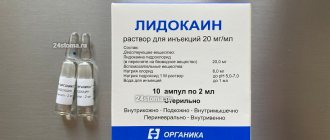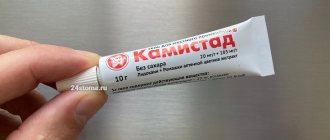Local anesthesia is used to numb sensations in a specific part of the body. This prevents pain during surgical procedures.
An anesthetic is applied to the part of the body that is undergoing surgery.
Can be used for sedation, which calms the patient and reduces stress levels. Together, they allow the surgeon to perform the procedure without pain or distress.
Local anesthesia does not last long, so it is mainly used for small outpatient procedures where the patient can leave the clinic the same day.
Advantages and disadvantages
For simple surgical interventions, local anesthesia is indispensable; it has advantages over other types of sensitivity suppression. The drug that is used, an anesthetic solution, acts strictly at the injection site, which helps to avoid severe complications and adverse reactions.
The blockade of pain sensitivity develops on average in 10-15 minutes. The effect lasts for an hour or more, so local anesthesia can reduce pain in the area of the postoperative wound. The patient’s consciousness does not suffer from the action of the local anesthetic, so after the manipulation he can leave the clinic and not be in the ward.
But local anesthesia has its drawbacks. Just a few years ago, it was widely used for operations on superficial tissues and extremities; methods for intravenous administration of drugs with simultaneous application of a tourniquet were developed. Intraosseous anesthesia was widely used. But due to the large number of adverse reactions and complications, these methods began to be used less frequently. And after receiving high-quality drugs for anesthesia, dangerous methods of pain relief were practically abandoned.
The disadvantage of the local method is its limited scope of application. It is effective for anesthesia of mucous membranes, skin and superficial tissues, but is not used for operations on the abdominal and pelvic organs, neck and head.
The infiltration type of local anesthesia cannot be used when operating on malignant tumors due to the possibility of tumor cells entering beyond the wound into other tissues. This increases the risk of developing metastases.
Intravenous anesthesia
This type of anesthesia refers to non-inhalation types of anesthesia, which are characterized by a long-lasting effect and a greater depth of effect compared to inhalation anesthesia. Intravenous anesthesia can be performed using the following drugs:
- Thiopental, Recofol, Oxybutyrate and Propofol - classic pain relief
- Fentathyl with diphenhydramine - neuroleptanalgesia, which can be carried out on spontaneous breathing or combined with artificial ventilation
- Sibazon with Fentathyl is ataralgesia, which provides superficial, gentle anesthesia and can be carried out with other types of anesthesia.
This type of anesthesia is used to remove abscesses and phlegmons that occur with complications; it is also possible to treat small benign tumors if their removal under general anesthesia is not possible.
Types of local anesthesia
Several types of local anesthesia are used in surgical practice, but some of them already have historical significance. The main methods of pain relief are the following:
- superficial anesthesia - pain sensitivity is suppressed after the anesthetic comes into contact with the surface of the tissue, most often used to anesthetize the mucous membranes. The anesthetic solution is applied by lubrication or irrigation, the effect lasts for 10 minutes;
- infiltration anesthesia - anesthesia by impregnation, or infiltration of tissue layers with a local anesthetic. The technique allows you to control the depth and width of the drug injection, depending on the intended incision. The medicine is injected carefully first into the subcutaneous area until the lemon peel effect appears, then the needle is gradually moved inward and an additional dose of the drug is injected;
- anesthesia according to Vishnevsky is an improved version of the infiltration method. A weak anesthetic solution is injected layer by layer under high pressure. A tight creeping infiltrate forms in the tissues. It spreads through the interfascial spaces and disrupts the conduction of impulses along the nerves passing through them. After cutting the wound, the liquid gradually flows out of the wound, so there is no risk of its absorption into the systemic circulation and the development of toxic reactions;
- conduction anesthesia is the essence of the method in anesthetizing a specific area of the body innervated by the nerve trunk. An anesthetic drug is injected into the tissue around the nerve; the technique is used for operations on the limbs;
- spinal anesthesia - the analgesic effect is achieved by injecting an anesthetic drug under the choroid of the spinal cord, the main place of drug administration is the lumbar region, and pain sensitivity in the pelvic organs and lower extremities disappears. But tactile sensitivity does not suffer;
- epidural anesthesia is a type of anesthesia in which a local anesthetic is injected into the space over the dura mater of the spinal cord, and a puncture is also performed in the lumbar region. Sensitivity is lost after 15-20 minutes, but the effect lasts for 3-4 hours. The use of this type of anesthesia allows you to resume activity early after surgery;
- bone anesthesia is a type of anesthesia in which an anesthetic solution is injected into spongy bone. Currently, it is practically not used; previously it was used for operations on the limbs.
Inhalation anesthesia
This is the most commonly used type of anesthesia, which is characterized by ease of implementation, relatively easy control and short duration of action, which is important for minor surgical interventions. Inhalation anesthesia is the administration of drugs through a mask, which ensures their entry into the organs of the respiratory system. Most often, Narcotan, nitrous oxide, Trilene, Ftorotan and Etran are used for this type of anesthesia. There is a certain problem - to achieve the desired result, it is necessary that the effect of anesthesia be deep, and this is fraught with serious complications. Therefore, this type of anesthesia is most often used in pediatric surgery. Children under anesthesia administered by inhalation feel excellent, they do not experience respiratory dysfunction, and complications are extremely rare.
Preparations for local anesthesia
Local anesthetics are drugs from the group of neurotropic drugs that completely or partially block the flow of signals along nerve fibers from the site of painful manipulation or surgery to the central parts of the nervous system.
The peculiarity of the action of drugs is related to their spectrum of action. They suppress the transmission of signals along myelinated type A nerve fibers, which transmit feelings of pain, smell, and temperature. Tactile sensations are carried out through type B fibers, and anesthetics do not affect them. Therefore, when using local anesthesia, the patient does not feel pain, but feels the touch of the doctor and the surgical instrument.
Local anesthetic drugs are divided into 3 groups depending on the duration of action:
- short-acting - the effect lasts 30-50 minutes, these include Novocain;
- average duration - up to 90 minutes, these are drugs Lidocaine, Trimecaine, Ultracaine;
- long-acting – the effect lasts more than 90 minutes, typical for Bupivacaine.
Local anesthetic drugs affect the electrochemical processes of ion exchange in nerve endings. Medicines work effectively in an alkaline environment and tissues rich in lipids, which include nerves. But the analgesic effect decreases with severe tissue inflammation, which is associated with a transition of pH to the acidic side.
The effect of local anesthetics is enhanced by drugs that affect vascular tone. Therefore, they are often combined with adrenaline to prolong the effect. This allows you to reduce the dose of pain medication and avoid toxic reactions.
What is operated under local anesthesia in mammology?
The mammary glands are located superficially, they do not have muscles and large nerve trunks. Breast tissue is loosely located; in young women, glandular tissue predominates, which is replaced by fatty tissue with age. Therefore, for numerous manipulations and operations, local anesthesia can be used.
In mammology, anesthesia is used to perform invasive diagnostics, which include breast tissue biopsy. To do this, a local anesthetic is injected with a thin needle into the area of the intended puncture. After 10-15 minutes, the doctor can take breast tissue for examination without fear of causing pain to the patient.
Local infiltration anesthesia in mammology is used for small, minimally invasive operations. A woman can undergo puncture of a breast cyst after preliminary infiltration anesthesia. A similar approach can be used when removing small benign breast tumors.
In men, anesthesia is used during surgery for type 1 gynecomastia, when the size of the gland is still small. Infiltration of tissues increases hydrostatic pressure in them, thanks to which the doctor can easily separate pathological tissues from healthy ones.
Other applications
Local anesthesia may also be used to diagnose some chronic conditions and to relieve pain after surgery.
Research has shown that local anesthesia may be more useful than opioids such as morphine for treating pain after total knee replacement surgery.
In 2010, results from a rodent study in Turkey showed that local anesthetics may reduce some symptoms of inflammatory bowel disease (IBD).
Anyone administering any type of anesthetic should be appropriately trained and qualified.
Is it painful to do local infiltration anesthesia?
When performing anesthesia, a standard disposable syringe with a thin needle is used. Whether local anesthesia is painful depends on your general pain threshold. The patient feels the moment of the first puncture of the skin and a slight feeling of fullness when the drug is administered. After the medication begins to act, sensitivity disappears. The doctor checks how effective the injection is by tapping the skin. In response, there is a feeling that the injection site has become woody.
After the end of anesthesia, sensitivity gradually increases, and a slight tingling sensation may appear. If anesthesia was performed for surgery, pain in the wound area begins to bother you, which can be reduced with the help of non-steroidal anti-inflammatory drugs.
Prices for tooth extraction at Apex-D dentistry
| Name | rub. |
| Opening an abscess | 500 |
| Abscess drainage | 350 |
| Removal of a single root tooth | 2000 |
| Removal of a double-rooted tooth | 2500 |
| Removal of a three-root tooth | 3000 |
| Removal of the third molar “wisdom tooth” of the upper jaw | 3000 |
| Removal of the third molar “wisdom tooth” of the lower jaw | 3500 |
| Root separation | 350 |
| Hemisection | 1500 |
| Osteotomy | 1500 |
| Socket curettage | 300 |
| Tamponade with iodoform turunda | 300 |
| Alvaugille | 300 |
| Neocones | 300 |
| Stitching | 750 |
| Periostotomy | 500 |
| Hemostasis | 200 |
| Cystectomy | 3000 |
| Cystectomy with resection of the apex of one root, frontal group | 4500 |
| Cystectomy with resection of the apex of one root, chewing group | 5500 |
| Cystectomy, resection of each subsequent apex | 1500 |
| Cystotomy | 1500 |
| Cyst removal | 1000 |
| Closed curettage | 1000 |
| Open curettage of one tooth area | 1500 |
Modern dental practice makes it possible in most cases to prevent tooth extraction. The doctor’s rule is to prescribe tooth extraction surgery only as a last resort, when all available treatment methods have been tried and it is no longer possible to save the tooth, or in the event that the problematic tooth is the cause of the development of more serious complications.
Contraindications for local anesthesia
Local infiltration anesthesia is a relatively safe method of pain relief. But to reduce risks during and after surgery, it is necessary to take into account contraindications to the use of the method. The main ones are the following:
- allergy to anesthetic - if earlier during dental treatment under local anesthesia an allergy to an anesthetic appeared, then during breast surgery the effect will repeat, and may be more pronounced, up to anaphylactic shock;
- psychomotor agitation and mental illness, reaction to the administration of an anesthetic and the surgical procedure itself can cause unpredictable behavior of the patient;
- during operations on malignant tumors - when infiltration anesthesia does not allow compliance with the ablastic rule;
- during long operations that require the use of microsurgical equipment;
- during interventions on areas of the body with a pronounced vascular network, for example, on the neck.
If local anesthesia is contraindicated, general anesthesia is preferred.
Endotracheal anesthesia
One of the most commonly used methods of anesthesia when performing complex surgical interventions is endotracheal anesthesia, which involves immersing the body in a state of deep narcotic (medicinal) sleep. At the same time, the muscles completely relax, and the patient does not breathe independently. To achieve the desired state, doctors carry out a set of measures for the patient:
- Tracheal intubation is the insertion of an endotracheal tube into the lumen of the trachea, which is needed to provide artificial ventilation of the lungs.
- Intravenous administration of narcotic anesthetics, sedatives and tranquilizers.
- Administration of muscle relaxants – they block neuromuscular transmission.
- Artificial ventilation.
The quality of endotracheal anesthesia depends not only on the experience of the anesthesiologist, but also on how correctly the patient’s condition is monitored. It is imperative to monitor blood pressure, pulse, and oxygen saturation.










